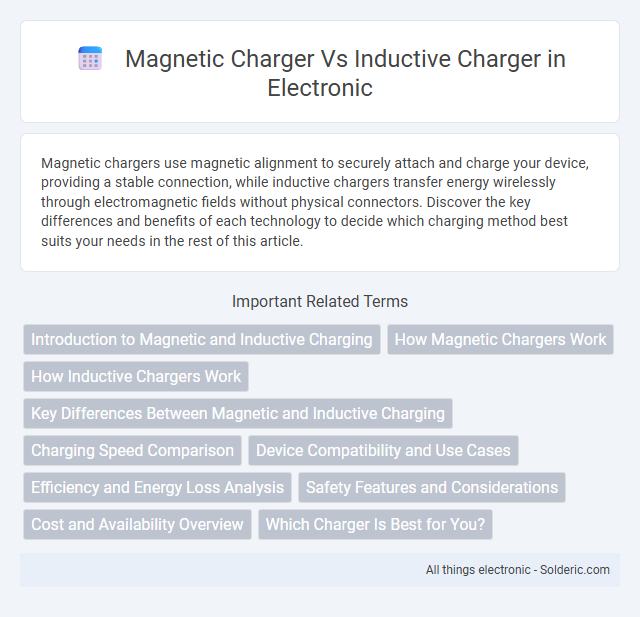Magnetic chargers use magnetic alignment to securely attach and charge your device, providing a stable connection, while inductive chargers transfer energy wirelessly through electromagnetic fields without physical connectors. Discover the key differences and benefits of each technology to decide which charging method best suits your needs in the rest of this article.
Comparison Table
| Feature | Magnetic Charger | Inductive Charger |
|---|---|---|
| Charging Method | Uses magnetic connectors for direct contact charging | Transfers power via electromagnetic induction without direct contact |
| Connection Type | Physical magnetic attachment | Wireless, no physical connection needed |
| Charging Efficiency | High efficiency, minimal energy loss | Moderate efficiency, some energy lost as heat |
| Device Compatibility | Requires compatible magnetic ports or adapters | Works with devices supporting Qi or similar standards |
| Setup Convenience | Easy alignment via magnetic attraction | Requires precise coil alignment for optimal charging |
| Durability | Potential wear at connectors from repeated use | No physical connectors, less wear and tear |
| Usage Scenarios | Ideal for fast, secure charging with cable management | Ideal for cable-free, convenient charging stations |
| Cost | Tends to be lower cost due to simpler tech | Generally higher cost due to complex electronics |
Introduction to Magnetic and Inductive Charging
Magnetic chargers utilize magnetic fields to create a secure and efficient connection between the power source and the device, enabling seamless wireless energy transfer. Inductive chargers operate on the principle of electromagnetic induction, where an alternating current in the transmitter coil generates a magnetic field that induces voltage in the receiver coil inside the device. Both technologies facilitate cable-free charging but differ in design efficiency, alignment sensitivity, and power transfer mechanisms.
How Magnetic Chargers Work
Magnetic chargers use magnets to align and securely attach the charging connector to the device, ensuring efficient power transfer through direct contact points. This alignment reduces energy loss and enhances charge speed by maintaining a stable electrical connection. Unlike inductive chargers that rely on electromagnetic fields, magnetic chargers deliver power through physical connectors embedded with magnetic coupling technology.
How Inductive Chargers Work
Inductive chargers function through electromagnetic fields by transferring energy between two coils--a primary coil in the charging base and a secondary coil inside the device. When an alternating current passes through the primary coil, it generates a magnetic field that induces a voltage in the secondary coil, wirelessly charging the device's battery. This technology eliminates the need for physical connectors, enhancing convenience and reducing wear on ports compared to magnetic chargers that rely on direct magnetic contact.
Key Differences Between Magnetic and Inductive Charging
Magnetic chargers use magnetic connectors to align and securely attach the charging cable to the device, enabling fast and reliable power transfer, whereas inductive chargers rely on electromagnetic fields to transfer energy wirelessly through coils without direct contact. Magnetic charging typically offers higher efficiency and faster charging speeds compared to inductive charging, which is often limited by alignment and coil distance. Inductive chargers provide greater convenience through true wireless charging but may suffer from increased energy loss and slower charging rates relative to magnetic solutions.
Charging Speed Comparison
Magnetic chargers typically offer faster charging speeds due to direct contact between the charger and device, minimizing energy loss during transfer. Inductive chargers rely on electromagnetic fields, which often result in slower charging rates and higher energy dissipation. Studies show magnetic charging can deliver up to 15-20% quicker charge times compared to standard inductive charging methods.
Device Compatibility and Use Cases
Magnetic chargers offer broad device compatibility by securely attaching to smartphones, smartwatches, and earbuds equipped with magnetic connectors, ensuring precise alignment for efficient charging. Inductive chargers support a wider range of Qi-enabled devices without requiring physical connectors, making them ideal for versatile use cases like charging multiple gadgets on a single pad. Your choice depends on whether you prioritize the convenience of magnetic attachment or the flexibility of universal inductive charging.
Efficiency and Energy Loss Analysis
Magnetic chargers typically exhibit higher efficiency due to direct magnetic coupling, minimizing energy loss during power transfer. Inductive chargers rely on electromagnetic fields and often experience greater energy loss through stray capacitance and resistance in coils. Energy efficiency in magnetic chargers can exceed 85%, while inductive chargers commonly operate between 70% and 80%, impacting overall charging speed and power consumption.
Safety Features and Considerations
Magnetic chargers use strong magnets to align the device and charger, reducing the risk of misalignment and overheating, enhancing user safety. Inductive chargers rely on electromagnetic fields for power transfer but can generate excess heat if the alignment is off, requiring built-in sensors to prevent damage. Your safety depends on choosing chargers with certified temperature control and foreign object detection features.
Cost and Availability Overview
Magnetic chargers typically offer a lower cost point due to simpler design and widespread compatibility with devices like smartphones and earbuds, making them highly available in the consumer market. Inductive chargers, often using more complex coil-based technology for wireless power transfer, tend to have higher manufacturing costs, which translates into elevated retail prices and less ubiquitous availability. Both charger types benefit from growing adoption, but magnetic chargers currently dominate in terms of affordability and ease of access across various electronic accessories.
Which Charger Is Best for You?
Magnetic chargers offer quick alignment with strong attachment, making them ideal for users seeking convenience and portability. Inductive chargers provide a broader, contactless charging area, perfect for maintaining device flexibility without precise placement. Your choice depends on whether you prioritize ease of connection or freedom of positioning during charging.
Magnetic charger vs Inductive charger Infographic

 solderic.com
solderic.com